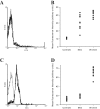Human pregnancy-associated malaria-specific B cells target polymorphic, conformational epitopes in VAR2CSA
- PMID: 17176260
- PMCID: PMC2779471
- DOI: 10.1111/j.1365-2958.2006.05503.x
Human pregnancy-associated malaria-specific B cells target polymorphic, conformational epitopes in VAR2CSA
Abstract
Pregnancy-associated malaria (PAM) is caused by Plasmodium falciparum-infected erythrocytes (IEs) that bind to chondroitin sulphate A (CSA) in the placenta by PAM-associated clonally variant surface antigens (VSA). Pregnancy-specific VSA (VSA(PAM)), which include the PfEMP1 variant VAR2CSA, are targets of IgG-mediated protective immunity to PAM. Here, we report an investigation of the specificity of naturally acquired immunity to PAM, using eight human monoclonal IgG1 antibodies that react exclusively with intact CSA-adhering IEs expressing VSA(PAM). Four reacted in Western blotting with high-molecular-weight (> 200 kDa) proteins, while seven reacted with either the DBL3-X or the DBL5-epsilon domains of VAR2CSA expressed either as Baculovirus constructs or on the surface of transfected Jurkat cells. We used a panel of recombinant antigens representing DBL3-X domains from P. falciparum field isolates to evaluate B-cell epitope diversity among parasite isolates, and identified the binding site of one monoclonal antibody using a chimeric DBL3-X construct. Our findings show that there is a high-frequency memory response to VSA(PAM), indicating that VAR2CSA is a primary target of naturally acquired PAM-specific protective immunity, and demonstrate the value of human monoclonal antibodies and conformationally intact recombinant antigens in VSA characterization.
Figures





References
-
- Cranmer SL, Magowan C, Liang J, Coppel RL, Cooke BM. An alternative to serum for cultivation of Plasmodium falciparum in vitro. Trans R Soc Trop Med Hyg. 1997;91:363–365. - PubMed
Publication types
MeSH terms
Substances
LinkOut - more resources
Full Text Sources
Miscellaneous

